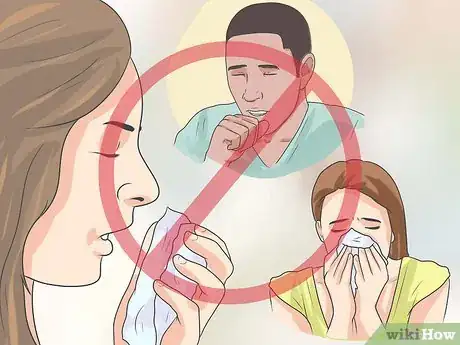This article was co-authored by Laura Marusinec, MD. Dr. Marusinec is a board certified Pediatrician at the Children's Hospital of Wisconsin, where she is on the Clinical Practice Council. She received her M.D. from the Medical College of Wisconsin School of Medicine in 1995 and completed her residency at the Medical College of Wisconsin in Pediatrics in 1998. She is a member of the American Medical Writers Association and the Society for Pediatric Urgent Care.
There are 13 references cited in this article, which can be found at the bottom of the page.
wikiHow marks an article as reader-approved once it receives enough positive feedback. In this case, 85% of readers who voted found the article helpful, earning it our reader-approved status.
This article has been viewed 236,475 times.
Being contagious means that you are capable of transmitting an illness to another person. Once you feel sick, knowing if you are contagious may prevent you from contaminating other people. Upper respiratory illnesses, like a cold and the flu, are caused by viruses and are easily transmitted to other people. Many infections caused by bacteria can also be highly contagious. If you discover that you are contagious, precautionary measures can help to prevent the spread of the illness.
Steps
Identifying the Symptoms of a Contagious Illnesses
-
1Take your temperature. A normal temperature range is 97.7 to 99.5°F (36.5 to 37.5°C). Anything above that is considered a fever and indicates that you are probably contagious. Having a fever with a cold is not as common as the fever associated with the flu, but either way it means you are contagious.
- Running a fever is your body’s way of fighting off the infection. Body temperature can be measured orally, rectally, in the ear, or under the arm, and may vary slightly with each method.[1] The fever associated with the flu can range from 100 to 102°F (37.8 to 38.9°C), and even higher in children. Expect the fever caused by the flu to last for three to four days in most cases.
- Body temperature is regulated through a structure in your brain called the hypothalamus. When you have an infection, the hypothalamus increases body heat to help get rid of the invading virus or bacteria.
-
2Examine your mucus and nasal secretions. Thick or discolored yellow/green mucus is a strong indication that you have an upper respiratory infection accompanied by inflammation in the respiratory tract.[2] It also means that you are most likely contagious.
- Children with thick white, yellow, or green drainage from their eyes usually are contagious as well, with "pink-eye" also known as conjunctivitis.
- Specific respiratory illnesses that involve thick or discolored mucus and nasal secretions include the common cold, sinusitis (inflammation of the sinus), epiglottitis (inflammation of the epiglottitis), laryngitis (inflammation of the larynx, and bronchitis (inflammation of the bronchus).
- The immune system increases the production of mucus in your nose to flush out the illness. This causes your nose to feel clogged, and indicates that you are contagious.
- Thick or discolored mucus that does not clear in about a week may warrant seeing a doctor. Your doctor can do tests to evaluate the cause of your symptoms, order treatments such as antibiotics, and determine if you are contagious.
Advertisement -
3Look for a skin rash. Certain skin rashes are often a sign of being contagious. Rashes that affect large portions of the body may be either allergic or viral. Viral rashes are the ones that mean you are contagious, like with illness such as chickenpox or the measles. Some bacterial infections that are contagious can cause skin rashes, such as scarlet fever (caused by streptococcus) or impetigo (caused by streptococcus or staphylococcus usually). Fungal infections can even cause contagious skin rashes such as ringworm or athlete's foot.
- There are two ways that viral rashes can spread. Viral symmetrical rashes start at the extremities, on both sides of the body, then spread towards the center of the body. Viral central rashes start from the chest or the back, then spread outward to the arms and legs.
- Viral rashes follow a pattern of spreading, either outward or inward, as just described. Rashes caused by allergies can appear anywhere on the body and do not have a specific pattern of spreading.
- Some viral rashes tend to stay in certain areas, such as the Coxsackievirus. When this virus causes hand, foot, and mouth disease, it causes a rash mainly in and around the mouth, on the hands and feet, and sometimes in the diaper area or on the legs.
-
4Watch for diarrhea, accompanied by a slight fever. Diarrhea can be a sign of having a contagious illness, especially when accompanied by vomiting and a low-grade fever. Diarrhea, vomiting, and a low-grade fever can be signs of gastroenteritis, often referred to as the stomach flu, or signs of rotavirus, norovirus or coxsackievirus, all of which are contagious.[3]
- There are two types of diarrhea: complicated and uncomplicated. Uncomplicated diarrhea includes symptoms of abdominal bloating or cramping, loose watery stools, a sense of urgency to have a bowel movement, and nausea and vomiting. Usually, diarrhea involves the passing of stool at least three times a day.
- Complicated diarrhea includes all the symptoms of uncomplicated diarrhea plus blood, mucus, or undigested food in the stool, accompanied by fever and weight loss or severe abdominal pain.
-
5Look for pain behind the forehead, cheeks and across the nose. Regular headaches are not usually an indication of a contagious disease. However specific types of headaches (where you feel pain in the face and forehead) can be a warning that you are contagious.
- Headaches that accompany the flu, and sometimes a cold, occur as a steady pain in the areas of the forehead, cheeks and bridge of the nose. The swelling and mucus buildup in the sinus areas causes the discomfort. The headache pain can be severe and may get worse when you bend over. Note that bacterial sinus infections are not usually contagious, nor are ear infections.
-
6Notice if your sore throat is accompanied by a runny nose. When you have a contagious illness, like the flu or a cold, the sore throat is often accompanied by a runny nose. A sore throat without a runny nose but with symptoms such as a fever, rash, or headache, can be a sign of strep throat. This is a bacterial infection which is very contagious.
- The sore throat is sometimes caused by postnasal drip, as fluids from your sinuses drip down the back of your throat, causing redness and irritation. The throat feels raw, irritated, and painful.
- When the sore throat and runny nose are accompanied by wheezing and itchy, watery eyes, it is likely that you are suffering from allergies rather than a contagious virus. The throat discomfort caused by allergies is still from post-nasal drip, but the throat feels dry and itchy.
-
7Pay attention to feelings of sleepiness and a loss of appetite. Contagious illnesses can cause you to feel very tired or sleepy, and to lose your appetite. Sleeping a lot and eating less are two ways in which your body conserves energy to fight infection.
Putting the Symptoms Together
-
1Recognize the symptoms of influenza, or the flu. Flu symptoms include fever, headache, general aches and body pain, extreme feelings of fatigue, and sometimes stuffy, runny nose, sneezing, cough, and chest discomfort. Influenza, or flu, symptoms begin more abruptly, progress quickly, and are more severe than symptoms from a cold. The flu also can lead to serious complications.[4]
- Someone with the flu is contagious for a day or so before symptoms start, then remains contagious for five to seven days once they appear. The CDC considers someone to be contagious until the fever is back to normal, without the help of medication, for 24 to 48 hours. If other symptoms linger, such as problems with coughing, runny nose, and sneezing, then you are probably still contagious. [5]
-
2Identify the symptoms of a cold. Typical symptoms that occur with a cold include a sore throat, stuffy or runny nose, cough, congestion, sneezing, mild chest discomfort, fatigue, and some general body aches and pain. Colds are contagious one to two days before symptoms appear, then continue to be contagious for the next two to three days when the symptoms are at their worst.[6]
- More than 200 viruses have been identified that cause people to catch a cold. This type of upper respiratory illness makes you feel bad, is annoying and uncomfortable, but is not usually associated with serious complications. Symptoms can linger for up to 10 days, but the most contagious time is within the first few days when symptoms are the strongest and when a fever is present.
-
3Pay attention to combined symptoms. Symptom groups such as diarrhea, nausea, and vomiting accompanied by muscle aches and headaches can mean that you have gastroenteritis, sometimes called the stomach flu, or even food poisoning. Gastroenteritis and food poisoning have similar symptoms. This can make it hard to tell which one you may have. However, the stomach flu, or gastroenteritis is contagious, and food poisoning is not.
-
4Consider the people you have been around that are sick. Most contagious illnesses can be caught for one or two days before symptoms develop. Learning what you have caught may be easier by understanding the recent illness of someone you have been exposed to, even if they were not yet sick when you were around that person.[7]
- Also consider the time of year. Many contagious illnesses are more common during certain times of the year. Flu season in the United States runs generally from November through March. Other diseases may be specific to certain countries or regions. Plus, seasonal allergens can vary depending on where you live.
-
5Rule out seasonal allergies. Some people have strong upper respiratory symptoms that are caused by seasonal airborne allergens. This type of illness is not contagious. Allergy symptoms overlap with those of a cold and the flu.
- Allergy symptoms include general weakness, stuffy, runny nose, sneezing, sore throat and coughing. People with allergies often have a lot of itching of their nose or eyes. While allergy symptoms can make you feel bad, you are not carrying a contagious illness. Your doctor can help by ordering lab tests that identify the cause of your allergies, and by prescribing the appropriate course of treatment.
- At first, it can be difficult to tell the difference between the symptoms of a cold, the flu, or seasonal allergies. After a day or so, the symptoms change. How fast they change and additional symptoms that develop can help you determine if your symptoms are from a contagious illness like a cold or the flu, or if the symptoms are caused by airborne seasonal allergens which are not contagious.
- Allergies are caused by an overactive immune system. Certain substances such as pollens, dust, animal dander, and some foods, trigger the immune system to fight them off as if they were harmful substances in our body.
- When that happens the body releases histamines to fight of the perceived intruders. Histamine creates symptoms common to a respiratory infection, such as sneezing, coughing, runny nose, nasal congestion, itchy and watery eyes, sore throat, wheezing and headaches.
Preventing the Spread of Contagious Illnesses
-
1Get the flu vaccine yearly. Scientists research and develop flu vaccines that are designed to prevent infection from the most likely strains of flu viruses. Every year the vaccine is different, so getting it one year does not protect you for the next round of flu season. Getting the flu vaccine is key in controlling the spread of the flu.[8]
- The flu vaccine protects you from the flu, not from other contagious illnesses you may be exposed to.
-
2Wash your hands. Upper respiratory illnesses, like a cold or the flu, are spread from person to person. A common way these illnesses are spread is by touching someone or something that has been contaminated with the virus.[9]
-
3Use soap and water. Wash with warm water and soap placed in the palm of your hand. Lather your hands by rubbing them together for at least 20 seconds. Be sure to cover all surfaces of your hand, including between your fingers, under your nails, and your wrists. Then rinse your hands well, use a paper towel to dry, and use a towel to turn off the faucet. Discard in the towel in the trash can.[10] germs off your hands by wash
-
4Clean your hands with alcohol gel. Squirt gel into the palm of your dry hand. Rub your hands together covering all surfaces until the gel dries. This takes about 15 to 20 seconds.
-
5Avoid contact with people that are sick. The flu virus can be spread by someone sick as far as six feet away. Coughing and sneezing creates tiny droplets that can travel through the air, landing on someone’s hands, their mouth, nose, or inhaled directly into their lungs.[11]
-
6Be aware of surfaces you touch. Door knobs, desks, pencils, and other objects can carry the virus germs from one person to another. Once you touch an object that has been contaminated with the virus, it is easy to then touch your mouth, eyes, or nose. This provides a way for that unwanted virus to enter your body. The flu virus can live for two to eight hours on surfaces.
-
7Protect yourself and other people from exposure. If you get sick, avoid contact with other people until your symptoms improve or your doctor says you are not contagious.[12]
- In the United States, estimates show that between 5% and 20% of the population get the flu every year. More than 200,000 people are hospitalized each year for complications and, each year, thousands of people die. The elderly, babies, pregnant women, and people that have compromised immune systems, or have asthma or other lung diseases, are at the greatest risk of developing complications. Protecting yourself from exposure, and preventing exposure to other people if you do get sick, can possibly save lives.
-
8Stay at home, isolated from other people. Try to stay in an isolated room at home, separate from other family members (especially kids) to avoid spreading the illness. Don't go to work or school, and don't send your children to school or daycare when they are contagious.
-
9Cover your mouth when coughing or sneezing. Coughing and sneezing into a tissue, or even into the bent part of your arm near your elbow, is better than spreading the infected droplets into the air.[13]
-
10Avoid sharing items. Bed sheets, towels, dishes, and utensils should be washed carefully before being used by other people.
Watching Out for Other Contagious Illnesses
-
1Be aware of other illnesses that can be contagious. While the flu and the common cold are certainly experiences most people have, there are many other contagious diseases, some of them serious, that should not be overlooked. Your doctor, or other healthcare provider, is a great resource for any illness or symptoms that develop that might be contagious.[14]
-
2Watch for those around you who are diagnosed with a serious infection. Some forms of hepatitis are contagious, as are some forms of meningitis. These conditions are serious and should not be ignored. If someone you know has been diagnosed with an infectious disease, consult your doctor to help determine if you are at risk.[15]
-
3Recognize childhood infections that are contagious. Most children receive vaccinations in their early years to avoid contracting serious illnesses, but sometimes contagious diseases can still be a problem. Discuss any evidence of infection or illness with your doctor or your child’s pediatrician. [16]
Expert Q&A
-
QuestionHow do I know when the fever from the flu is gone?
 Laura Marusinec, MDDr. Marusinec is a board certified Pediatrician at the Children's Hospital of Wisconsin, where she is on the Clinical Practice Council. She received her M.D. from the Medical College of Wisconsin School of Medicine in 1995 and completed her residency at the Medical College of Wisconsin in Pediatrics in 1998. She is a member of the American Medical Writers Association and the Society for Pediatric Urgent Care.
Laura Marusinec, MDDr. Marusinec is a board certified Pediatrician at the Children's Hospital of Wisconsin, where she is on the Clinical Practice Council. She received her M.D. from the Medical College of Wisconsin School of Medicine in 1995 and completed her residency at the Medical College of Wisconsin in Pediatrics in 1998. She is a member of the American Medical Writers Association and the Society for Pediatric Urgent Care.
Board Certified Pediatrician If you have not had a fever (over 100.4) in the last 24 hours, then the fever is most likely gone. You can check your temperature once every few hours to keep track of it. During this time, you should also avoid taking medications that can reduce a fever, such as acetaminophen (Tylenol), ibuprofen, or aspirin.
If you have not had a fever (over 100.4) in the last 24 hours, then the fever is most likely gone. You can check your temperature once every few hours to keep track of it. During this time, you should also avoid taking medications that can reduce a fever, such as acetaminophen (Tylenol), ibuprofen, or aspirin. -
QuestionWhat if you have a headache and you feel dizzy?
 Laura Marusinec, MDDr. Marusinec is a board certified Pediatrician at the Children's Hospital of Wisconsin, where she is on the Clinical Practice Council. She received her M.D. from the Medical College of Wisconsin School of Medicine in 1995 and completed her residency at the Medical College of Wisconsin in Pediatrics in 1998. She is a member of the American Medical Writers Association and the Society for Pediatric Urgent Care.
Laura Marusinec, MDDr. Marusinec is a board certified Pediatrician at the Children's Hospital of Wisconsin, where she is on the Clinical Practice Council. She received her M.D. from the Medical College of Wisconsin School of Medicine in 1995 and completed her residency at the Medical College of Wisconsin in Pediatrics in 1998. She is a member of the American Medical Writers Association and the Society for Pediatric Urgent Care.
Board Certified Pediatrician Make sure you are drinking plenty of liquids and getting enough rest. Don't overexert yourself if you are feeling dizzy or if you have a bad headache. Try taking acetaminophen or ibuprofen for your headache. You can also place a cool wet washcloth on your forehead. If the headache is severe or not improving, or if you are feeling very dizzy or faint, contact your doctor right away.
Make sure you are drinking plenty of liquids and getting enough rest. Don't overexert yourself if you are feeling dizzy or if you have a bad headache. Try taking acetaminophen or ibuprofen for your headache. You can also place a cool wet washcloth on your forehead. If the headache is severe or not improving, or if you are feeling very dizzy or faint, contact your doctor right away.
References
- ↑ https://medlineplus.gov/ency/article/003400.htm
- ↑ https://www.mayoclinic.org/diseases-conditions/common-cold/symptoms-causes/syc-20351605
- ↑ https://www.mayoclinic.org/diseases-conditions/infectious-diseases/symptoms-causes/syc-20351173
- ↑ https://www.cdc.gov/flu/symptoms/symptoms.htm
- ↑ http://www.nhs.uk/chq/Pages/1068.aspx?CategoryID=67&SubCategoryID=150
- ↑ http://www.nhs.uk/chq/Pages/1068.aspx?CategoryID=67&SubCategoryID=150
- ↑ http://www.cdc.gov/flu/about/disease/spread.htm
- ↑ http://www.ncbi.nlm.nih.gov/books/NBK337/
- ↑ https://www.cdc.gov/handwashing/when-how-handwashing.html
- ↑ http://www.ucsfhealth.org/education/hospital_precautions/
- ↑ http://www.cdc.gov/flu/about/disease/spread.htm
- ↑ https://www.mayoclinic.org/diseases-conditions/infectious-diseases/in-depth/germs/art-20045289
- ↑ http://www.lung.org/lung-health-and-diseases/lung-disease-lookup/influenza/preventing-influenza.html
- ↑ http://www.ncbi.nlm.nih.gov/books/NBK337/
- ↑ https://www.nfid.org/infectious-diseases/
- ↑ http://www.nlm.nih.gov/medlineplus/infectiousdiseases.html
About This Article
If you're sick, there are certain symptoms you can watch for that might mean you're contagious, like running a fever, thick or discolored mucus, diarrhea accompanied by a fever, or a sore throat accompanied by a runny nose. You might also feel tired and lose your appetite if your illness is contagious. If you're experiencing a skin rash in addition to other symptoms, it could be a sign that you have a viral or bacterial infection that's contagious. Whatever symptoms you're experiencing, if you think you're contagious, it's best to stay home from school or work so you don't get anyone else sick. For advice from our Medical co-author, like how to prevent spreading a contagious illness, scroll down.























































































Medical Disclaimer
The content of this article is not intended to be a substitute for professional medical advice, examination, diagnosis, or treatment. You should always contact your doctor or other qualified healthcare professional before starting, changing, or stopping any kind of health treatment.
Read More...